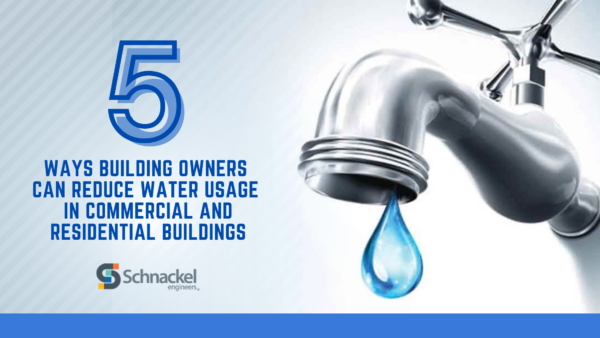5 Ways Building Owners Can Reduce Water Usage in Commercial and Residential Buildings

Conserving our precious natural resources is becoming ever more important in building design and construction. Water is one of those natural resources that has been becoming more scarce over time, particularly in arid regions. As an engineer, it is our responsibility to design the building systems to reduce the amount of water usage and advise building owners of the best ways to achieve this.
Water usage is unavoidable in building construction and operations. USGBC and many other industry related societies and local jurisdictions have provided information on how to achieve water usage reduction. Manufacturers are continuously improving their products and fixtures to keep reducing the water usage in buildings. These improvements along with innovative engineering will keep raising the bar when it comes to water reduction.
Here are five ways building owners can reduce water usage in commercial and residential buildings:
1. Low Flow Plumbing Fixtures – New or Retrofit
Prior to 1992 plumbing fixtures were permitted to flow at very high flow rates in comparison to the flow rates typically seen today. Water closets have dropped from 3.5 gallons per flush (gpf) to as low as 1.1 gpf, urinals have dropped from 2 gpf to as low as 0 gpf, and lavatory faucets have dropped from 3.0 gallons per minute (gpm) to as low as 0.35 gpm. Most jurisdictions across the country require the EPA minimum requirements of 1.6 gpf water closet and 1.0 gpf urinals, and require a lower flow at the lavatory faucets of 0.5 gpm. LEED and a number of jurisdictions across the country require those minimums to be bettered by at least 20%. Building codes continue to be updated to force water use reduction as water availability continues to be diminished.
2. Sensor Faucets
One of the biggest wastes of water is when users keep faucets running for long periods of time when not actually using the water. This can include shaving, brushing teeth, or just forgetting to shut it off when finished washing their hands. Installing sensor operated faucets can greatly reduce or eliminate this wasted water. This is an easily accomplished replacement that any qualified plumber can complete. Sensor operated faucets can be either battery operated or hardwired, if power is readily available.
3. Individual System Metering
Water sub-meters are relatively inexpensive and provide the owner the opportunity to monitor all of their systems for efficiency and leaks. Irrigation and cooling tower systems can be sub-metered, and in some jurisdictions be used as deduct meters for reduced utility company charges. This data can then be reviewed on a routine basis to make sure the systems continue to operate at their highest efficiency, and hidden leaks can be identified and repaired quickly.
4. Irrigation Controls
Have you ever noticed a lawn sprinkler system running during a rain storm and wasting water? Water saving opportunities such as this can easily be implemented with the correct irrigation controls. The use of weather based and soil sensing controls is a great way to reduce water usage. Changing planting types to reduce or eliminate water requirements is also an effective strategy to reduce water consumption. A qualified landscape architect or botanist can provide guidance on low water use plants that are indigenous to your area.
5. Alternate Water Sources
The use of harvested rain water is an alternate water source to consider. Harvested rain water is water taken from the roof drains of the building, piped to a storage tank, minimally treated, and pumped to serve various locations such as, cooling towers, landscape irrigation, and even toilets and urinals. Installing a “greywater” system is a more sophisticated alternative approach, in which water is taken from the drains of showers, lavatories, and clothes washers, treated and then re-used for toilets and urinals, resulting in a very substantial reduction in the amount of fresh water used by the facility. Greywater systems require extensive changes to the piping systems in a building, so they are most often suitable for new construction or major renovation projects.
Final thoughts
The availability of fresh water is essential for life on earth. The design, construction, and operation of commercial and residential buildings plays a crucial role in saving our fresh water resources. When a building’s plumbing system is inefficient, it can lead to wasted water usage and increased operating costs. Building owners, on the other hand, can take a variety of active measures to achieve high levels of water efficiency and preserve this precious natural resource, while also optimizing the performance and lowering the cost of operating their facilities.
To learn more about how we can help you design the most sustainable and cost-effective plumbing system for your project, contact Schnackel Engineers!
Comments
Comments are closed.